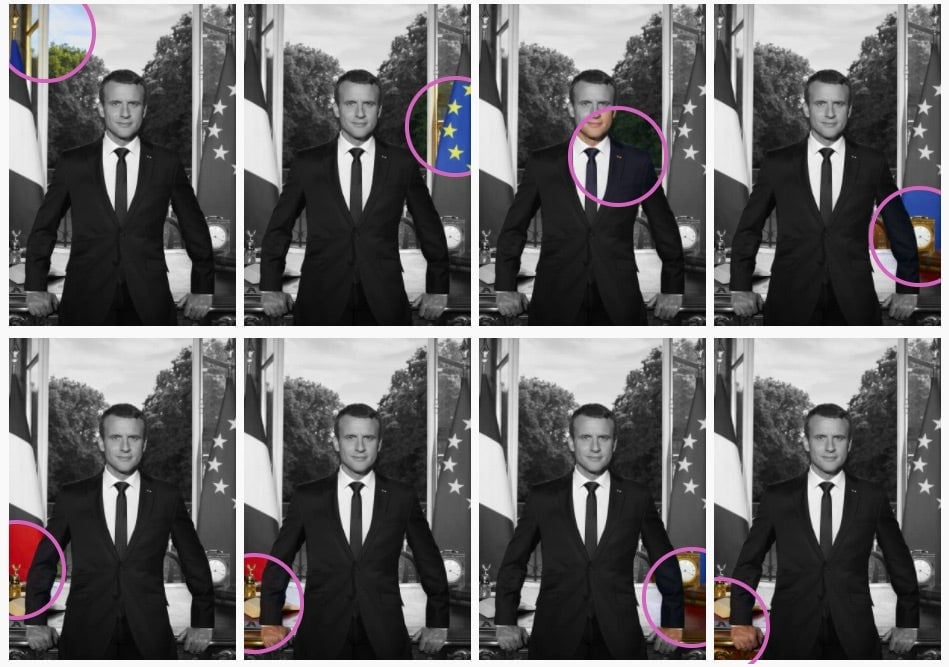Emmanuel Macron’s official portrait is a symbolic celebration of centrism
With a two-word tweet, French president Emmanuel Macron unveiled his official portrait yesterday. Taken in his office at the Élysée Palace 46 days after being sworn into office, the 39-year-old centrist’s striking portrait is a masterclass in soft-power symbolism. Electronically disseminated via the Élysée Palace’s website, the photograph’s Photoshop log reveals at least 91 versions saved since June 24, with the last tweak made minutes before Macron’s tweet.


With a two-word tweet, French president Emmanuel Macron unveiled his official portrait yesterday. Taken in his office at the Élysée Palace 46 days after being sworn into office, the 39-year-old centrist’s striking portrait is a masterclass in soft-power symbolism. Electronically disseminated via the Élysée Palace’s website, the photograph’s Photoshop log reveals at least 91 versions saved since June 24, with the last tweak made minutes before Macron’s tweet.
Working with his official photographer, Soazig De La Moissonnière, Macron carefully planned the location, pose, props, and publicity for the portrait, which will decorate the walls some 50,000 French government outposts around the world. In the tradition of power portraiture in art history, the so-called “Jupiterian president” carefully chose props that hint at his personality and underscore his centrist politics. Every detail matters.
Between two flags
Macron, who founded a new party and defeated far-right candidate Marine Le Pen with a centrist platform, poses between the French Tricolor and the European Union flag. He presents himself as a temperate arbiter of France’s domestic interests and the EU’s supranational agenda. Giving the EU banner equal prominence with the French flag is likely to incite the country’s legion of eurosceptics, but Macron is firm on his belief in the bloc’s mission. At his victory celebration, Macron walked to the podium with the EU’s anthem, Ludwig van Beethoven’s Ode to Joy, playing in the background.
Exposed to the elements
The wide-open windows behind Macron says that France is open to the world. With the view of the Élysée Palace’s English-style garden, Macron’s evenly lit indoor/outdoor portrait is a deft mashup of his two predecessors’ official portraits. (Conservative Nicolas Sarkozy posed in the official residence’s library surrounded by leather clad books and “man-of-the-people” François Hollande posed in the garden.) The tall trees framing Macron’s head also hints at his advocacy for environmental preservation policies and defense of the Paris climate agreement.
Power pose
With the faint trace of wrinkles on his forehead, France’s youngest president faces the camera head-on, elbows akimbo, grinning confidently like a CEO on the cover of a magazine. His casual expression is offset by the determined, knuckle-grip on the executive desk—a sign of his firm handle on his duties, or possibly a nod to the traditions of the French presidency. (The antique Louis XV style desk was moved from its original position in front of the fireplace to get a view of the garden in the shot.)
Symbolic fashion
Wearing an impeccably fitted jacket and his trademark skinny tie, Macron appears modern and youthful. Unlike other French politicians who spend thousands in haberdashery, Macron’s modest suit is likely bought off-the-rack from his favorite Parisian brand, Jonas et Cie. On his lapel is a military decoration. By virtue of this office, Macron is the Grand Maître of the Légion d’Honneur and entitled to wear the Grand Croix, the highest level of that order.
Twice devoted
Two gold rings on Macron’s left and right hands accentuate the portrait’s symmetry. One ring is his wedding band, and the other is a sentimental token from wife Brigitte Trogneu. Macron received the band as he was leaving France for a six-month internship at the French embassy in Nigeria in 2001. “It is both with the same woman,” he assured reporters who probed him about the rings during the presidential campaign.
Round-the-clock president
On Macron’s right is a gold clock borrowed from the Council of Ministers’ chambers (Salon Murat), where the cabinet meets weekly. The hands of the clock indicate 8:20, the time the photograph was snapped. This is a significant detail, explains art historian Daniel Sherman to Quartz. “The clock reminds one of Jacques-Louis David’s famous but heavily fictionalized portrait of Napoleon, which purports to show him startled by the chimes of a clock,” he notes. The time is “reasonable but still, by French standards, early. He is known for sleeping very little.”
French classics
Three French literary classics are on the desk, which Macron seems group thematically. On the side of the EU flag is Stendhal’s Le Rouge et le Noir, which satirizes the French social order during the Bourbon Restoration period, and Les nourritures terrestres by Nobel Prize-winning writer André Gide, which was inspired by his travels to North Africa.
On the side of the French flag is a volume from Mémoires de guerre written by former president Charles de Gaulle, the author of the current republican government system (Fifth Republic), as news agency LCI reported. A revealing behind-the-scenes clip shows Macron searching for a particular passage in de Gaulle’s memoirs just before the photoshoot began. He bookmarks the page and lays it open on the side of the French flag.
Peeking behind Mémoires de guerre is a decorative paperweight in the shape of a Gallic rooster, a popular national symbol of France.
Separate lines
The most remarkable (and dating) props are the two smartphones on the edge of the desk, on his right side. A champion of the tech startup sector, Macron carefully stacked his two iPhones, as shown in the behind-the-scenes clip tweeted by the Palace’s press officer. It may be a coincidence, but Macron chose to unveil his portrait on June 29, the same day the first iPhone went on sale 10 years ago.